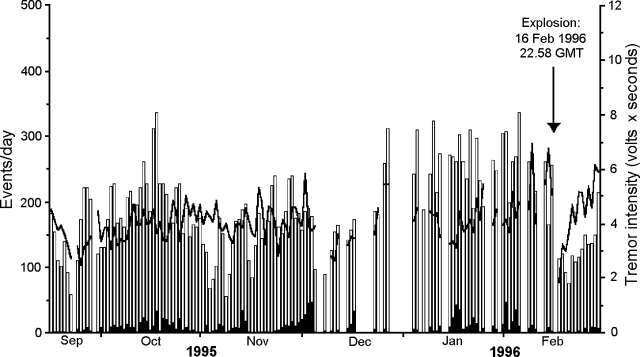Report on Stromboli (Italy) — February 1996
Bulletin of the Global Volcanism Network, vol. 21, no. 2 (February 1996)
Managing Editor: Richard Wunderman.
Stromboli (Italy) Intense eruptive phase followed by a drop in seismicity
Please cite this report as:
Global Volcanism Program, 1996. Report on Stromboli (Italy) (Wunderman, R., ed.). Bulletin of the Global Volcanism Network, 21:2. Smithsonian Institution. https://doi.org/10.5479/si.GVP.BGVN199602-211040
Stromboli
Italy
38.789°N, 15.213°E; summit elev. 924 m
All times are local (unless otherwise noted)
The following presents previously unreported observations of October 1995 activity made by Roberto Carniel (University of Udine), and seismicity recorded near the summit since mid-September 1995. A contribution from the Istituto Internazionale di Vulcanologia (IIV) provides information about a significant explosive event on 16 February.
October 1995 activity. Abundant light fumarolic activity was seen in the crater area on 13 October 1995 by Carniel. A shallow lava pond in vent 3/1 (see map in BGVN 20:11/12) was inferred by continuous night glow and ejection of small spatters that sometimes reached 3-4 m above the crater rim and only rarely fell outside the vent area. The other active vent in the SW crater (vent 3/2) produced regular explosions, with ejecta reaching considerable heights. Crater 2 was quiet, exhibiting neither explosions nor the gas-jet activity that often characterizes this crater. In Crater 1, the only activity occurred at a hole in cone 1/4; it consisted of continuous gas puffing, strong glow visible during the day, and very short blasts of air and smoke. Vent 1/1 was also active, although its eruptions were not as spectacular as those from 3/2, with occasional emission of a black cloud and ejection of sufficient material to trigger noteworthy movement of pyroclasts down the Sciara del Fuoco.
Mauro Coltelli (IIV) noted that the low lava fountains reported during August-October (BGVN 20:11/12) were typical of the Strombolian activity at the volcano, which was relatively low during that period.
Seismicity recorded at the summit, September-December 1995.Seismic activity recorded by the University of Udine summit station during the last three months of 1995 showed little variation in volcanic tremor intensity (figure 47). The daily number of recorded events was low (<100) in mid-September, reached a maximum of 337 on 18 October, and then decreased again until November. This period was interesting because of rapid transitions between days of very quiet activity (3-5 and 8-9 November) and days with a greater number of events (6-7 November). The minimum of the period was reached on 8 November, with only 53 events recorded during a full day of operation. A greater number of stronger events (either more energetic or less shallow) was recorded at the end of November and in early December (high of 46 events on 4 December).
January-February 1996 activity. January and the first half of February showed increased seismicity, with an average of 200-300 events/day and higher tremor intensity recorded at the summit. IIV reported that explosive activity during the first half of February remained low, ranging from days with an explosion almost every hour to days with a very few explosions. The main activity consisted of Crater 3 explosions that ejected minor spatter and ash puffs. Crater 2 exhibited continuous degassing, rarely interrupted by short periods of low-level spattering. Crater 1 produced daily strong gas explosions, sometimes with minor spatter.
At 2258 GMT on 16 February the seismic stations of the IIV permanent network on Stromboli recorded a sequence of explosion events, some of which were characterized by remarkable amplitudes. The events occurred in a very short time and were followed by increased tremor amplitude lasting ~12 minutes. Thereafter, the increment of tremor amplitude gradually vanished. The seismicity marked an intense eruptive phase from the summit craters. Eyewitnesses in Stromboli village reported a strong blast followed in the next few minutes by some incandescent bombs and glow on the summit; a dark column rose 200-300 m above the craters. No significant activity was observed by local residents for the next several hours. An IIV field survey on 20 February revealed that the bombs fell on an area 200-300 m wide. Both black scoriaceous bombs, covered by Pele's hairs, and reddish fumarolized blocks were observed; the vent that produced these materials was probably in Crater 2 or 3, but no relevant morphological variation of the shape of these craters was observed.
The University of Udine summit seismic station showed a general drop in activity after the event (figure 47). This repeats the pattern already observed after the explosions of 10 February and 16 October 1993 (BGVN 18:01 and 18:09) and after the small lava flow of May 1993 (BGVN 18:09), when similar abrupt decays were observed. The following days show increasing seismicity in terms of both tremor intensity and number of events.
Geological Summary. Spectacular incandescent nighttime explosions at Stromboli have long attracted visitors to the "Lighthouse of the Mediterranean" in the NE Aeolian Islands. This volcano has lent its name to the frequent mild explosive activity that has characterized its eruptions throughout much of historical time. The small island is the emergent summit of a volcano that grew in two main eruptive cycles, the last of which formed the western portion of the island. The Neostromboli eruptive period took place between about 13,000 and 5,000 years ago. The active summit vents are located at the head of the Sciara del Fuoco, a prominent scarp that formed about 5,000 years ago due to a series of slope failures which extends to below sea level. The modern volcano has been constructed within this scarp, which funnels pyroclastic ejecta and lava flows to the NW. Essentially continuous mild Strombolian explosions, sometimes accompanied by lava flows, have been recorded for more than a millennium.
Information Contacts: Roberto Carniel, Dipartimento di Georisorse e Territorio, Univ. di Udine, via Cotonificio 114, I- 33100 Udine; Mauro Coltelli, IIV (URL: http://www.ingv.it/).


